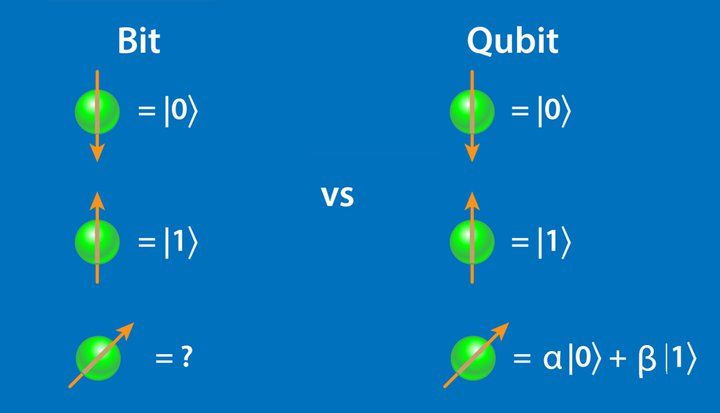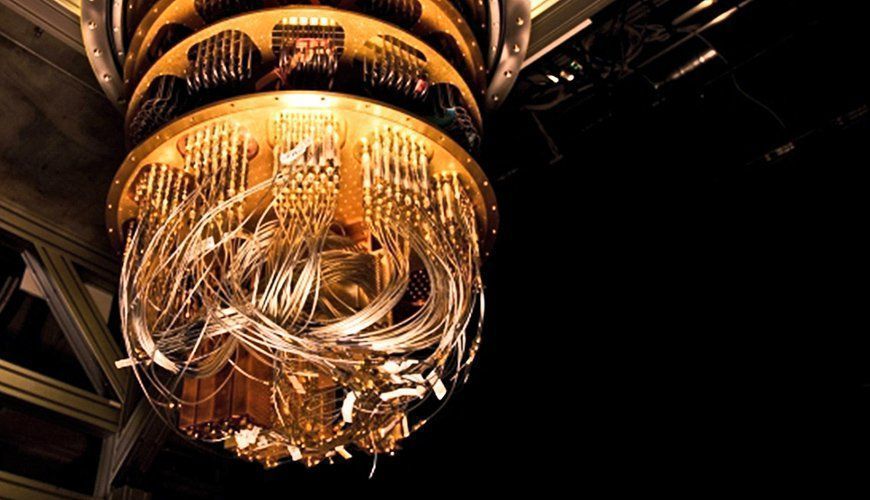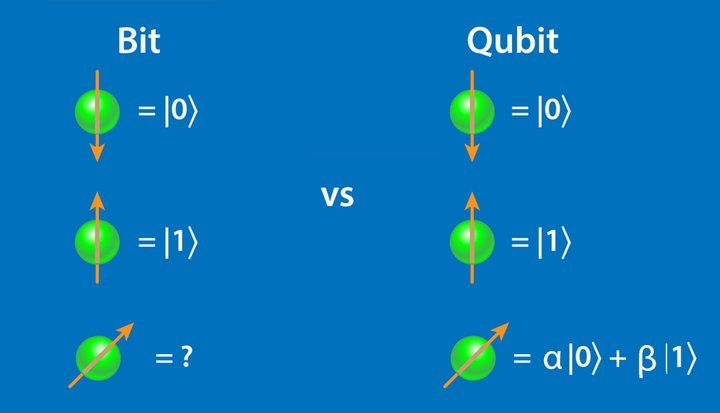What Is A Quantum Computer And How Does It Affect Security?
Quantum computers are basically based on quantum physics and have a much higher computing power than supercomputers.
What is a quantum computer and how does it work?
As mentioned, the structure of quantum computers is different from that of classical computers. Classical computers work with transistors, and data is practically stored and used in bits of 0 and 1. As you know, bits definitely have a unit value of 0 or 1 at any given moment.
In quantum computers, however, instead of a transistor-based structure, they use manipulation of subatomic particles and use spin (Spin is the property of subatomic particles, which is a quantum property).
In these computers, instead of bits, we have quantum bits, which we call Qubit. We denote the basic state of the qubits by | 0> and | 1> (and read as coat 0 and coat 1).
 Compare bits and qubits –
Compare bits and qubits –
To better understand this, suppose we toss a coin, the moment the coin is fixed on the ground, it is definitely the shape of a coin. Now imagine that we roll the same coin on the edge, on the table.
Can we say that a lion has appeared or a line while the coin is spinning? Definitely not. In fact, at any given moment, the coin has a lion probability and a line probability at the same time.
The function of the qubits is basically the same as that of a coin circulating on the edge. Qubits use the Superposition property, which can have values of 0 and 1 at the same time as a probability.
We show this with the following format and formula. The two numbers α and β are actually two complex numbers that apply to the following formula.
This superposition feature and other features such as entanglement make quantum computers ideal systems for special computing.

Is security compromised by quantum computers?
The subject of quantum computers has been discussed since the 1980s and will be used in the design and testing of new drugs, weather forecasting, data analysis, artificial intelligence, and more.
But one of the applications of quantum computers in the field of computers is in the field of cryptography. As you know, the issue of security is quite relative, and what we call security today may not have any security in a few years.
The RSA algorithm is currently used as a secure algorithm on the Internet in most high-security communications, such as banking. The basis of this algorithm is the existence of a very large natural number such as N that cannot be broken by the first factors (or power prime).
Finding these first factors of a large number is a very difficult task (NP-Complete) that takes billions of years to obtain on ordinary computers and even supercomputers.
But quantum computers, in a very short time, due to their structure and high speed, can obtain these factors using algorithms such as Shor (which is one of the most famous and important quantum algorithms). So the current security we have is generally in question.
However, this concern is not really present at this time, because although we have had quantum algorithms for many years, quantum computers are not available to us.
On the other hand, quantum computing itself can also help increase security. In fact, if we have a quantum communication channel, we can transfer data and keys through this secure channel and experience unparalleled security.
Some work has already been done on quantum computers.
Examples include IBM and Google quantum computers, as well as Honeywell’s new 10-qubit H1 quantum computer.
Finally, quantum computers can be used to solve problems that require a lot of memory and computing, but it seems that the use of supercomputers in the future will be even more than quantum computers.
What is a quantum computer?
As the market for rumors of Google’s latest achievement heats up, it looks like for the first time, a quantum computer has been able to perform a calculation a billion times faster than the world’s most powerful supercomputer today. For this reason, we look at the structure of the quantum computer and what awaits us in the not-too-distant future.
You may not believe what power is hidden in our pockets.
We mean today’s smartphones that have more processing power than half a century ago military supercomputers that took up the space of a room.
At the height of World War II, the head of IBM thought that just five versatile computers like the ENIAC were enough to solve all the world’s problems; But today, computers are becoming more and more ubiquitous in human life, and our dependence on their use is growing.
The development of computers and supercomputers is progressing so rapidly that it is predicted that by 2040, the power consumption of all computers and mobile devices will exceed the power of today’s technologies to generate energy, and the world will see massive blackouts.
However, computer and electronics engineers at companies such as Intel, ARM (Qualcomm chip maker), and Nvidia are designing faster, less expensive, and more efficient processors; But most researchers are trying to turn quantum computers from laboratory tools into commercial products.
Quantum computers are far faster and more efficient than today’s electronic computers, and they can revolutionize the evolution of human civilization by solving problems that the most advanced electronic supercomputers are unable to process.
But what is a quantum computer, how does it work, and what is its use?
D-Wave Quantum Computer: D-Wave, a Canadian company, is one of the first suppliers of commercial quantum computers, and its quantum processor processes 2,000 qubits.
The D-Wave processor is based on a seamless cooling process and is used in the calculation of optimization problems, so some experts do not consider this processor to be a quantum processor.
Limitations of electronic computer
Today’s computer hardware is based on electronic components called “transistors”. You may be familiar with writing numbers in base 2 and calculating them in school math class.
Bypassing or disconnecting the electric current in the transistors, the values 0 and 1 can be defined and complex calculations can be performed on them.
The computing power of today’s most advanced supercomputer, called SUMMIT, is 122.3 petaflops, which means that it can perform 122,300,000,000,000,000,000 calculations per decimal number per second; But supercomputers are incapable of solving some complex problems, such as breaking the cryptocurrency of banking transactions or breaking down very large numbers into prime factors.
Quantum physics and qubits
Imagine throwing a plastic ball constantly at the wall in front of you. Each time you repeat this, you will see that the ball bounces off the wall. In other words, the ball always stays on the other side of the wall and is never seen on the other side of the wall.
This experiment is an example of a large-scale phenomenon described by “classical physics” and “Newtonian mechanics”.
Now, if we make the dimensions of the ball and the wall smaller and smaller, we will face strange consequences.
Imagine a ball the size of an electron particle and the opposite wall is a dense barrier with no holes for electrons to pass through.
If we throw electrons into this wall several times, we see that sometimes it bounces back, sometimes it appears beyond the wall (as if tunneling through the wall), and sometimes it gets trapped inside the wall.
In other words, throwing an electron into an impermeable wall does not always have the same effect, and the electron returns, tunnels, or gets trapped with different probabilities.
This experiment is an example of a micro-scale phenomenon described by “quantum physics” and we explain these different states with a mathematical inventory called the “wave function”.
Using quantum phenomena, physicists have been able to construct a qubit (unit of quantum information). In the case where the electronic bits are either off (0) or on (1), the qubits can have 0, 1, or any value between them.
To better understand, imagine a sphere.
In the electronic computer, each bit can only be on the North Pole or the South Pole; But qubits can be placed anywhere on the surface of the sphere; So qubits can store much more information.
Quantum calculations are also performed on the qubit wave function, and since more information is processed at each stage of the computation; The processing speed of a quantum computer increases exponentially.
Note: Open the image in a new window to view the infographic in a large size.
The revolution of quantum computers
Quantum computers are not going to replace electronic computers. Putting the qubits in fragile quantum states and keeping them in this state requires very difficult and extremely cold conditions (close to absolute zero).
To provide these special conditions, diluent cooling systems are used, the structure of which is shown in the infographic below. Quantum computers solve only certain problems faster than electronic supercomputers, and supercomputers will continue to be an important part of future hardware.
It is difficult to accurately predict the impact of quantum computers on the progress of human civilization and its impact on daily life; But big companies like IBM, Google, Microsoft, and even Intel have big plans to build a commercial quantum computer.
Increasing the accuracy of computer simulations, especially quantum micro-scale phenomena, designing and testing new drugs, weather forecasting, data analysis, and artificial intelligence will be among the most important applications of quantum computers.
A few simple examples
1- We want to find the password of the encrypted file. The only solution is to guess the password and try it out. There are n possible modes for the answer, and the time required to guess and test a possible option is the same for all of them.
There are no tips or hints for finding the preferred answer, and randomly selecting options is no different than selecting them in a specific order.
If we use ordinary electronic computers to select and test the password, on average, we get results after 2 / n attempts; This means that if we do this several times with electronic computers, the average number of successful attempts will be close to 2 / n.
If we use quantum computers to solve this problem, the time required to obtain the correct password will be proportional to n√ (radical n).
You see, the larger the number n, the faster the quantum computer responds.
Searching large databases is one such example. Suppose you have a phone book with 100 million names and numbers registered. If you want to search for a title in this office phone with a regular computer, it takes an average of 50 million operations to get the answer; But with a quantum computer, you get the answer after 10,000 operations.
2- Numerical analysis of 617 digits (corresponding to 2048 bits) to the first factors is one of the problems that electronic supercomputers can not solve, But an ideal quantum computer with 4,096 qubits can solve this problem in 110 days.

 Compare bits and qubits –
Compare bits and qubits –